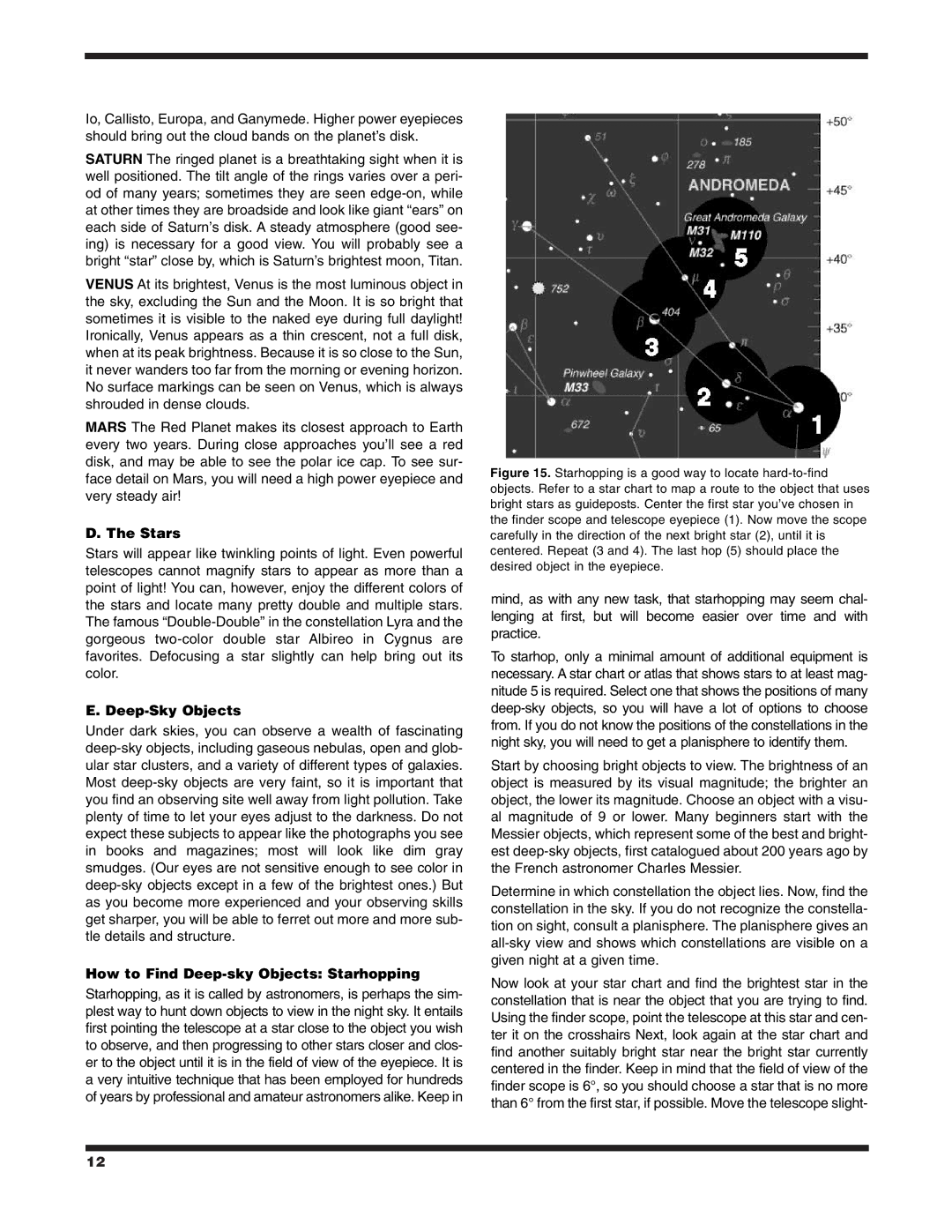
Io, Callisto, Europa, and Ganymede. Higher power eyepieces should bring out the cloud bands on the planet’s disk.
SATURN The ringed planet is a breathtaking sight when it is well positioned. The tilt angle of the rings varies over a peri- od of many years; sometimes they are seen
VENUS At its brightest, Venus is the most luminous object in the sky, excluding the Sun and the Moon. It is so bright that sometimes it is visible to the naked eye during full daylight! Ironically, Venus appears as a thin crescent, not a full disk, when at its peak brightness. Because it is so close to the Sun, it never wanders too far from the morning or evening horizon. No surface markings can be seen on Venus, which is always shrouded in dense clouds.
MARS The Red Planet makes its closest approach to Earth every two years. During close approaches you’ll see a red disk, and may be able to see the polar ice cap. To see sur- face detail on Mars, you will need a high power eyepiece and very steady air!
D. The Stars
Stars will appear like twinkling points of light. Even powerful telescopes cannot magnify stars to appear as more than a point of light! You can, however, enjoy the different colors of the stars and locate many pretty double and multiple stars. The famous
E. Deep-Sky Objects
Under dark skies, you can observe a wealth of fascinating
How to Find Deep-sky Objects: Starhopping
Starhopping, as it is called by astronomers, is perhaps the sim- plest way to hunt down objects to view in the night sky. It entails first pointing the telescope at a star close to the object you wish to observe, and then progressing to other stars closer and clos- er to the object until it is in the field of view of the eyepiece. It is a very intuitive technique that has been employed for hundreds of years by professional and amateur astronomers alike. Keep in
Figure 15. Starhopping is a good way to locate hard-to-find objects. Refer to a star chart to map a route to the object that uses bright stars as guideposts. Center the first star you’ve chosen in the finder scope and telescope eyepiece (1). Now move the scope carefully in the direction of the next bright star (2), until it is centered. Repeat (3 and 4). The last hop (5) should place the desired object in the eyepiece.
mind, as with any new task, that starhopping may seem chal- lenging at first, but will become easier over time and with practice.
To starhop, only a minimal amount of additional equipment is necessary. A star chart or atlas that shows stars to at least mag- nitude 5 is required. Select one that shows the positions of many
Start by choosing bright objects to view. The brightness of an object is measured by its visual magnitude; the brighter an object, the lower its magnitude. Choose an object with a visu- al magnitude of 9 or lower. Many beginners start with the Messier objects, which represent some of the best and bright- est
Determine in which constellation the object lies. Now, find the constellation in the sky. If you do not recognize the constella- tion on sight, consult a planisphere. The planisphere gives an
Now look at your star chart and find the brightest star in the constellation that is near the object that you are trying to find. Using the finder scope, point the telescope at this star and cen- ter it on the crosshairs Next, look again at the star chart and find another suitably bright star near the bright star currently centered in the finder. Keep in mind that the field of view of the finder scope is 6°, so you should choose a star that is no more than 6° from the first star, if possible. Move the telescope slight-
12
